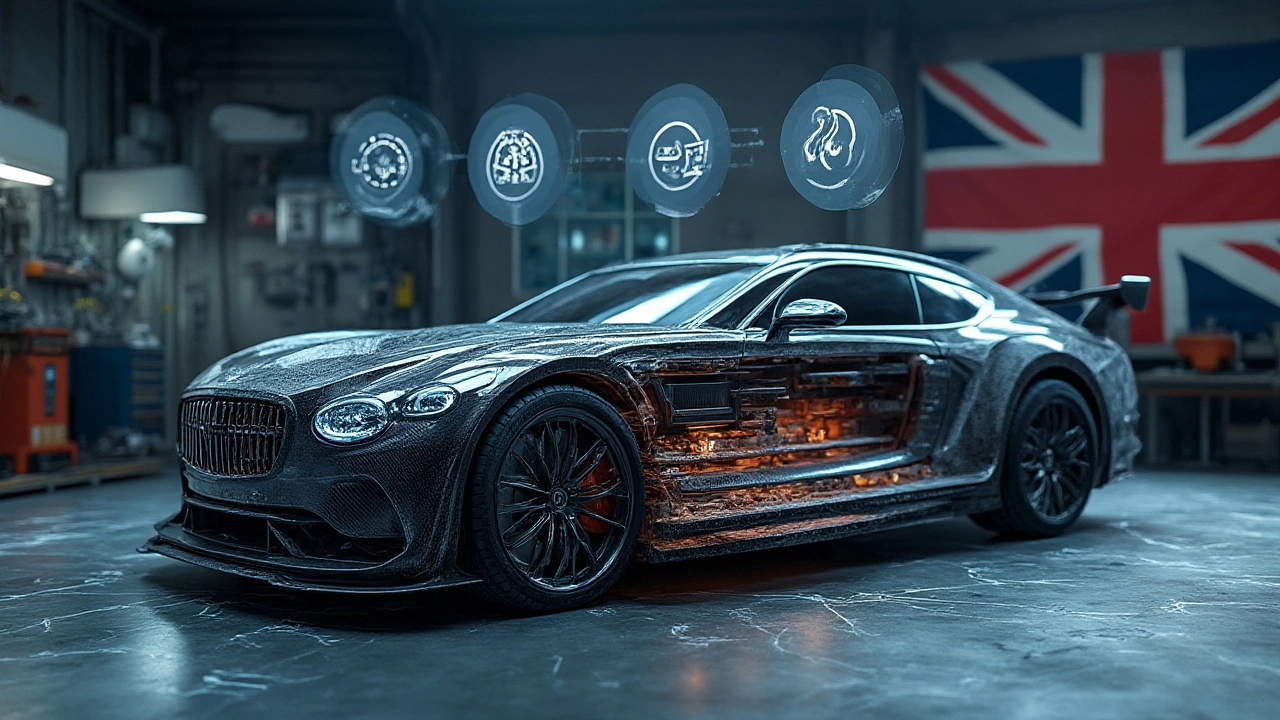So you’re eyeing those slick, lightweight carbon fiber car parts―or maybe you’ve already splurged on a set of racing-inspired carbon fiber pieces. There’s something hypnotic about that woven pattern reflecting in the sunlight. But is this wonder material actually built to last, or is it all just high-dollar hype? With carbon fiber popping up everywhere in the automotive world, from hoods to spoilers to interiors, it’s worth digging into what you’re really getting for your money―and how you can make those eye-popping upgrades stay sharp for years. Spoiler: you might be surprised at just how tough (or not) carbon fiber can be in real-world Aussie conditions.
What Makes Carbon Fiber Last (and What Doesn’t)
Carbon fiber’s legendary reputation for strength comes from a unique structure. It’s a blend of carbon atoms bundled together into super-thin strands, then woven into a fabric and set in a resin matrix. This pairing of fibers and resin makes the material both super strong and pretty lightweight—exactly what motorsport engineers have drooled over for decades. The real trick is that longevity depends on both the quality of the actual carbon fiber AND the type of resin holding it all together.
Let’s break this down. On its own, carbon fiber is absurdly strong for its weight—think up to 10 times stronger than steel, yet at about a quarter of the weight. However, it’s the resin (usually an epoxy) that protects those fibers from the elements, UV rays, and damage from impacts. If that resin layer gets scratched, chipped, or starts to yellow, the inner carbon weave becomes vulnerable.
Here’s where it gets real for Australian car owners: sunlight is the enemy. UV radiation from our harsh sun is notorious for breaking down resin over time. If you leave a carbon fiber part exposed without proper UV protection, you’ll start to see fading, yellowing, and even cracks in the clearcoat. Think of it like what happened to those old plastic headlight covers on late-nineties Holdens. And Melbourne weather—hot sun one day, rain the next—puts your carbon fiber through a constant test.
But that’s not all. Quality varies, sometimes wildly. Top-end OEM parts from a name like BMW M or Ferrari will use high-quality resin, precise curing, and multiple coats of UV-resistant clear. Cheaper aftermarket pieces—especially some “carbon look” knockoffs from overseas—might skip steps in manufacturing, meaning they’ll start to degrade sooner. Keeping an eye out for trusted brands and real certification helps a lot here.
Then there are the other enemies: stone chips, bird droppings, road salt, and even the acidic sweat from your hands if you go for that carbon shift knob. Even something as innocent as a car wash brush can scuff the clearcoat. Each of these issues chips away at the protective layers, letting water and dirt sneak in and threaten the long-term life of your upgrades.
For actual numbers? Well-made, genuine carbon fiber body panels can easily last over 20 years with just basic maintenance, and some have been clocking in 30+ years in gentler climates. Cheaply-made ones? You might notice discoloration, hazing, or delamination in two to five years—sometimes even sooner if you’re parking outside year-round.
| Type | Lifespan (Properly Maintained) | Common Issues |
|---|---|---|
| OEM (Original Equipment Manufacturer) | 20–30+ years | UV yellowing (rare), chips, scratches |
| High-quality Aftermarket | 10–20 years | UV fading, clearcoat failure |
| Low-cost Aftermarket | 2–7 years | Cracking, yellowing, delamination |
Real-World Experiences: How Carbon Fiber Ages
I’ve seen carbon fiber age on cars all over Melbourne. On the Saturday Cars and Coffee circuit, you’ll spot everything from old Nissan Skylines with original Nismo bonnets to near-new Teslas with a carbon rear lip. One thing jumps out: how wildly the condition varies depending on who owns the car and how they care for it.
My mate Mike runs a restoration shop in Carlton. He’s worked on some wild builds over the years, including an E46 M3 with its original carbon roof. According to him, most of the OEM stuff still looks sharp well over a decade in—even with typical city driving wear and tear—but only if the owners protected them from too much sun and hit them with a ceramic coat now and then. One customer let his carbon bonnet go uncovered for about eight years, and you could see the resin dull and yellow, with “spider web” cracks creeping across areas that faced direct UV. Once resins begin to degrade, you can’t polish out that yellowing—it’s deep, irreversible damage.
But sometimes, I’m blown away by how robust these parts can be—even in tough conditions. There’s a local WRX owner, Anna, who tracked her car every month for nearly five years. Her carbon splitter picked up endless stone chips and plenty of scrapes, but with regular clearcoat touch-ups, it never delaminated or fractured. That’s a testament to both the original build quality and attentive care.
You’ll also run into carbon fiber that hasn’t aged gracefully. A bloke at the local meet once showed off a ‘carbon look’ rear diffuser that had started peeling and bubbling near the exhaust after only two years. Turns out it wasn’t true carbon fiber but a plastic overlay. The heat from the exhaust and Melbourne’s wacky weather lifted the fake finish right off. Lesson learned: know real carbon versus stick-on cosmetic stuff.
If you like data, there’s a famous study from the US National Institute of Standards and Technology (2011) that simulated sunlight exposure on carbon fiber panels. Under intense UV, some panels lost up to 30% of their structural strength in under four years if left unprotected. Australian sunlight is just as intense, so if you daily drive or park in the open, protection is everything.
And don’t ignore the little things: road rash at 100km/hr can eat through that resin quickly. Frequent stone chips that aren’t filled can open up micro-cracks for water to seep in, which is the start of bigger problems like delamination.
If you’re into numbers and specifics, a well-maintained, high-quality carbon fiber hood can still carry its full strength and appearance for more than two decades. Poorly maintained parts or cheap copies might need replacing after 3–6 years. Location matters—a car garaged in Adelaide will often outlast one left in Melbourne’s notorious four-seasons-in-an-hour climate.

Maintenance That Makes Carbon Fiber Last
Want your carbon fiber parts to last through city commutes, outback trips, and back again? It all comes down to basic but consistent care. Unlike painted steel parts, you can’t just slap on a quick wax once a year and forget about it. The secret sauce is defending that resin layer before damage starts.
Here’s a practical rundown of tips every carbon-fiber fan in Australia should keep in mind:
- Keep your car covered if possible. UV rays are the single biggest threat. A garage or high-quality cover goes a long way. If parking outdoors, invest in a reflective sunshade and try to rotate the car every few days.
- Wash with a gentle auto shampoo, not dish soap, and use a microfiber mitt. Harsh cleaners can haze or dull the clear resin layer.
- Dry thoroughly—carbon fiber can absorb water around cracked resin edges, so always dry after cleaning, especially around seams.
- Apply a UV protectant formulated for composites at least three or four times a year. Some folks swear by ceramic coatings—they make water bead off and block a lot of sunlight.
- Wax isn’t dead—some automotive waxes have UV blockers. Just check that it won’t yellow the resin over time (look for ones made for clearcoat or fiberglass).
- Quickly buff out light scratches using polish made for plastic or fiberglass, not regular car paint cutting compounds, which are too harsh.
- Keep an eye out for chips or cracks. Fill with a resin repair kit (widely available at auto parts stores). Small nicks grow if ignored.
- Avoid automatic car washes with brushes—manual washing is a pain, but it’s gentler on the resin coat.
- If you live near the ocean, wash often to get rid of salty spray, which can speed up resin breakdown.
- If winter brings hail or frost in your area (yes, even in Melbourne from time to time), consider temporary padding or shelter. Resin can get brittle with sharp temperature swings.
Every few years, you might need to add a new layer of clearcoat if the existing one starts to haze. Many detailers offer this, but you can tackle it yourself with careful sanding and spraying if you’re comfortable. Keep the original shape and don’t sand all the way down to the fibers, or you’ll compromise strength.
One thing I learned from Emily: be fussy about keeping hands clean when touching the interior carbon fiber trim. The oils from your skin can slowly dull those glossy surfaces—you can always tell which M3s are driven by detail fanatics just by peeking inside.
And don’t skimp—proper care might cost a little extra in time and money, but it’s way more affordable than forking out for a new carbon splitter because of resin rot or yellowing that couldn’t be polished out. If you want your car’s “wow” factor to last, baby that clearcoat like you would the paint on a show car.
When to Repair and When to Replace
Even with the best care, sometimes the elements or a rogue shopping trolley get the last word. So, when do you pull out the repair kit, and when is it time to retire your carbon dream?
Minor annoyances—like light scratches, small chips, or cloudiness—can often be treated with polish, resin filling kits, or a fresh clearcoat. Many DIYers in Melbourne swear by marine epoxy for small touch-ups, thanks to its extra toughness. If you notice only surface-level damage, regular repair can keep things looking sharp for years. And if you do have to sand and polish, always work in gentle layers. The actual carbon weave is strong, but if you go too deep with sandpaper, you risk cutting through the protective layer and compromising structure.
The trouble comes when you see any of these signs:
- Yellowing that goes all the way through the resin (not just on top)
- White or grey ‘spider-web’ cracks radiating from an impact point
- Areas where the weave has lifted, bubbled, or separated (delamination)
- Water seeping under the clearcoat, making the part look hazy from below
- Any flexing, warping, or soft spots, especially near bolts or mounting points
Once carbon fiber delaminates or the resin loses integrity, that part is on borrowed time. It might look fine when parked, but the structural safety is gone, especially for things under load—like splitters, bonnets, or seat backs. Experienced detailers or composites shops can sometimes patch up the layers, but if the fiber itself is broken, it’s time to replace the piece for safety’s sake.
The cost to fix versus the cost to replace? For small, non-structural items, a repair might be $150–500, depending on size and severity. Bigger parts, like a full carbon bonnet, could run to several grand. Sometimes it’s more sensible to swap it out. And trust me, nothing deflates that “I’ve got carbon” excitement like a part that’s literally peeling apart around you at 100km/hr.
Don’t forget—genuine carbon fiber is recyclable, but only specialised workshops can process it. So, if you do have to bin a delaminated part, check for a composites recycler near you.
The real triumph of carbon fiber isn’t just its durability; it’s the way it lifts a car’s look and feel—if you treat it right. By understanding the reasons behind wear, taking a few preventive steps, and knowing when to act, you’ll get the best possible return on your investment and keep those heads turning at every set of lights—for years, not months.




